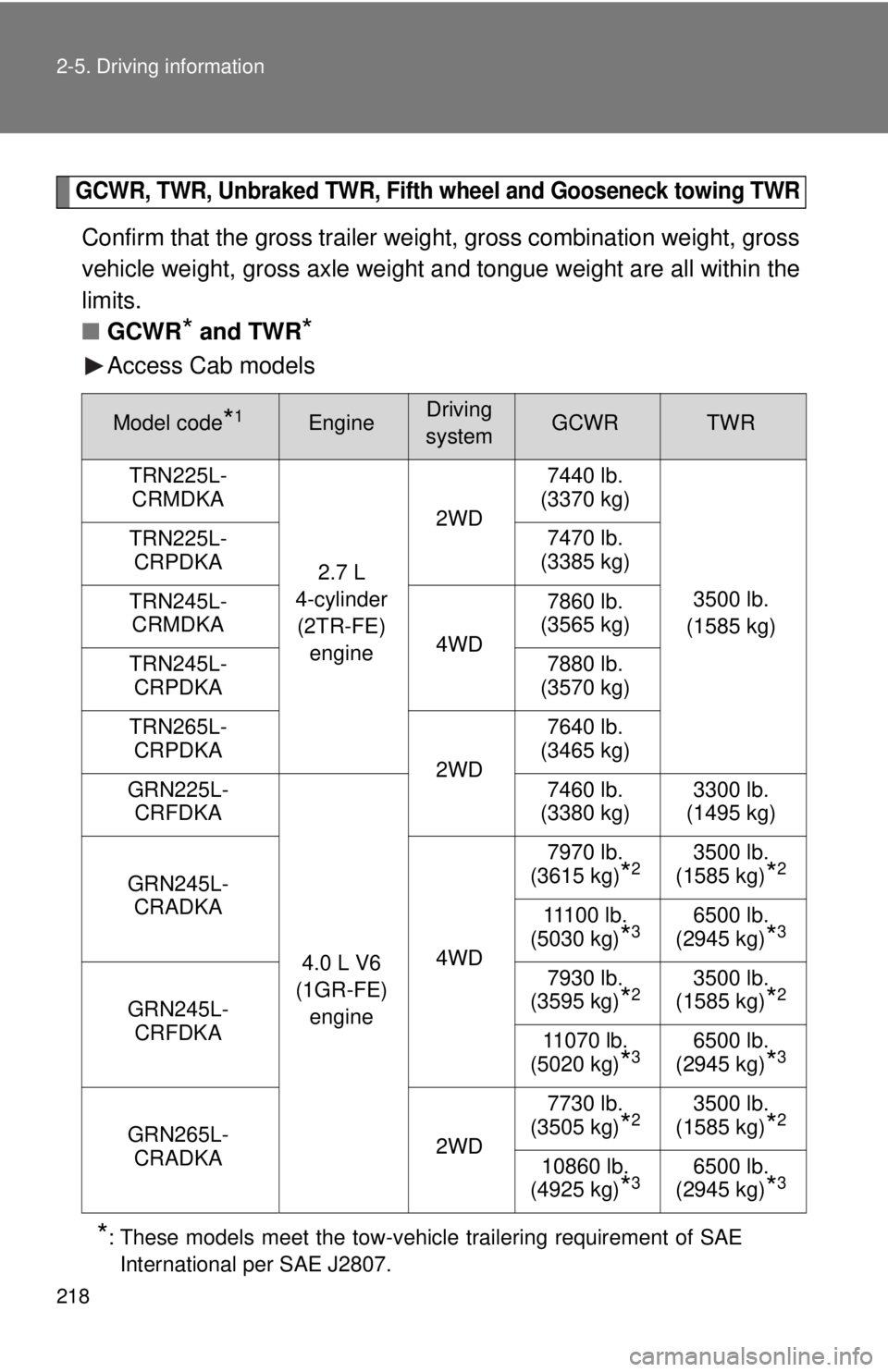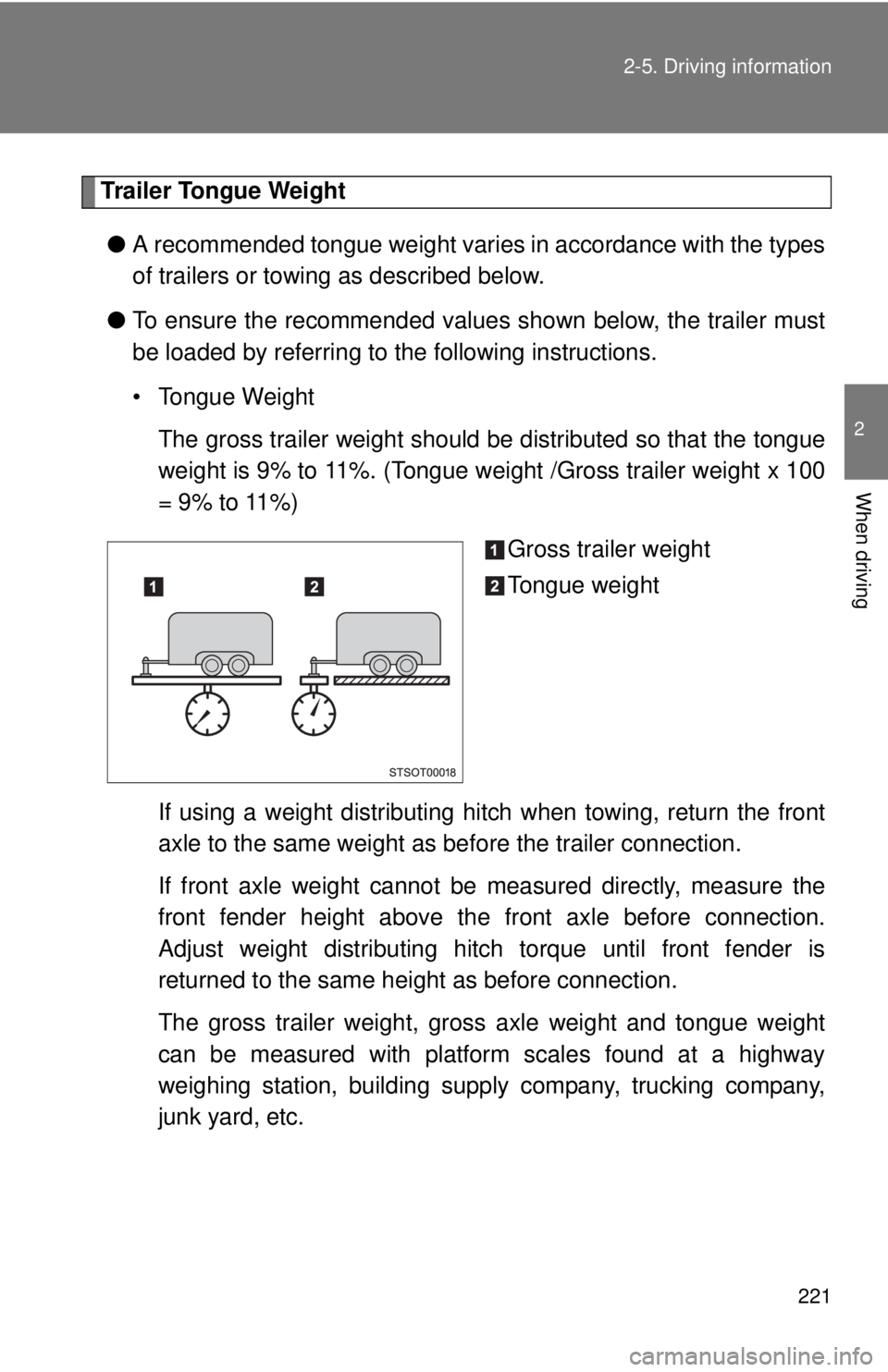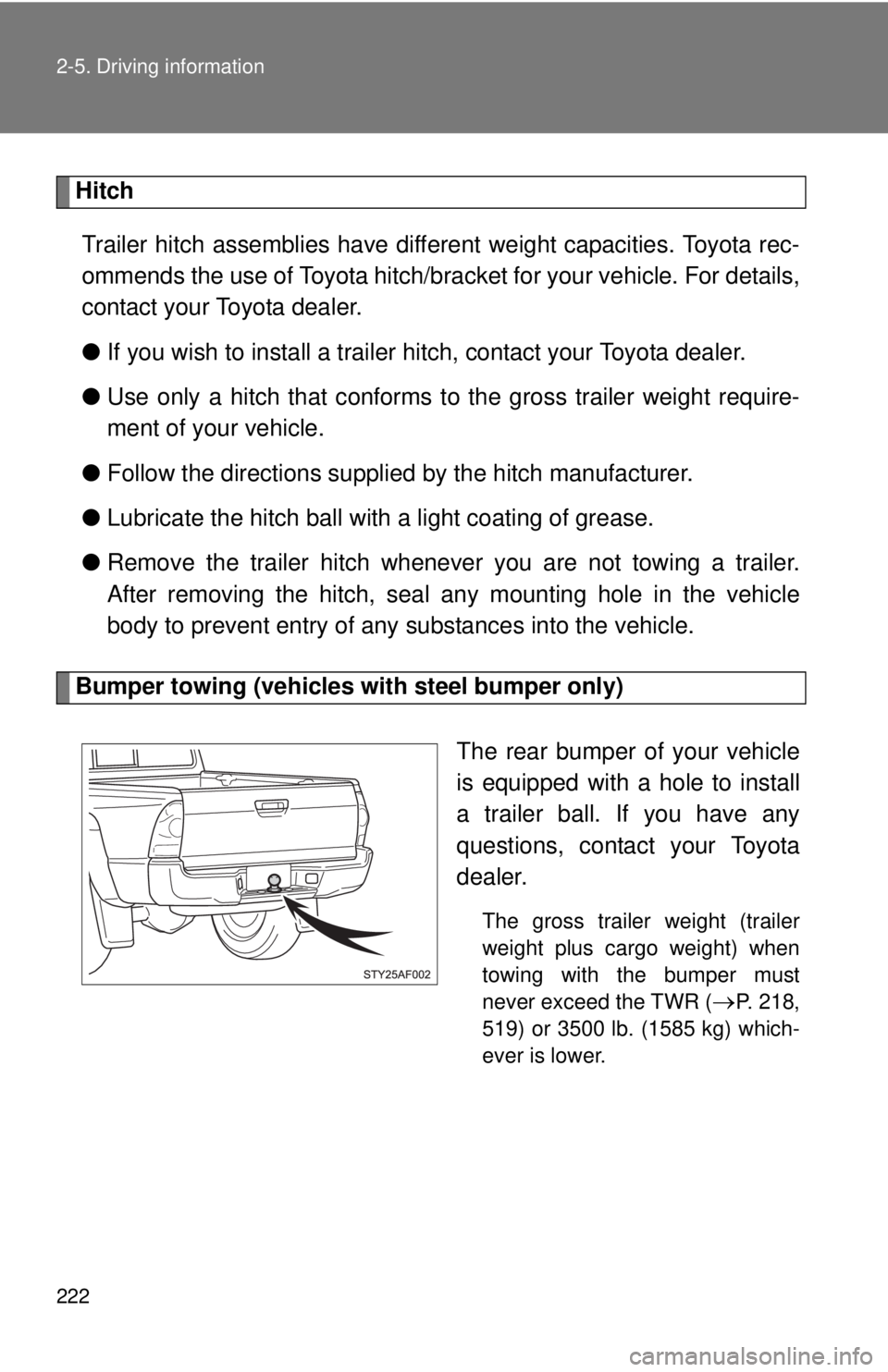Page 214 of 590
214 2-5. Driving information
Towing related terms■ GCWR (Gross Combination Weight Rating)
The maximum allowable gross
combination weight. The gross
combination weight is the sum of
the total vehicle weight (including
the occupants, cargo and any
optional equipment installed on
the vehicle) and the weight of the
trailer being towed (including the
cargo in the trailer).
■ GVWR (Gross Vehi cle Weight Rating)
The maximum allowable gross
vehicle weight. The gross vehicle
weight is the total weight of the
vehicle. When towing a trailer, it
is the sum of the vehicle weight
(including the occupants, cargo
and any optional equipment
installed on the vehicle) and the
tongue weight.
Page 215 of 590
215
2-5. Driving information
2
When driving
■
GAWR (Gross Axle Weight Rating)
The maximum allowable gross
axle weight. The gross axle
weight is the load placed on
each axle (front and rear).
■ TWR (Trailer Weight Rating)
The maximum allowable gross
trailer weight. The gross trailer
weight is the sum of the trailer
weight and the weight of the
cargo in the trailer.
TWR is calculated assuming
base vehicle with one driver, one
front passenger, towing package
(if available), hitch and hitch sys-
tems (if required).
Additional optional equipment,
passengers and cargo in the vehi-
cle will reduce the trailer weight
rating so as not to exceed
GCWR, GVWR and GAWR.
If the gross trailer weight exceeds
3000 lb. (1360 kg), it is recom-
mended to use a trailer with 2 or
more axles.
Front GAWR
Rear GAWR
(With brakes)
Page 216 of 590
216 2-5. Driving information
■Unbraked TWR (Unbraked Trailer Weight Rating)
The trailer weight rating for tow-
ing a trailer without a trailer ser-
vice brake system.
■ Tongue Weight
The load placed on the trailer
hitch ball. (P. 221)
(Without brakes)
Page 218 of 590

218 2-5. Driving information
GCWR, TWR, Unbraked TWR, Fifth wheel and Gooseneck towing TWR
Confirm that the gross trailer weight, gross combination weight, gross
vehicle weight, gross axle weight and tongue weight are all within the
limits.
■GCWR
* and TWR*
Access Cab models
*: These models meet the tow-vehicle trailering requirement of SAE
International per SAE J2807.
Model code*1EngineDriving
systemGCWRTWR
TRN225L- CRMDKA
2.7 L
4-cylinder (2TR-FE) engine 2WD
7440 lb.
(3370 kg)
3500 lb.
(1585 kg)
TRN225L-
CRPDKA 7470 lb.
(3385 kg)
TRN245L- CRMDKA 4WD7860 lb.
(3565 kg)
TRN245L- CRPDKA 7880 lb.
(3570 kg)
TRN265L- CRPDKA 2WD7640 lb.
(3465 kg)
GRN225L- CRFDKA
4.0 L V6
(1GR-FE) engine 7460 lb.
(3380 kg) 3300 lb.
(1495 kg)
GRN245L- CRADKA
4WD7970 lb.
(3615 kg)
*23500 lb.
(1585 kg)
*2
11100 lb.
(5030 kg)
*36500 lb.
(2945 kg)
*3
GRN245L- CRFDKA 7930 lb.
(3595 kg)*23500 lb.
(1585 kg)
*2
11070 lb.
(5020 kg)
*36500 lb.
(2945 kg)
*3
GRN265L- CRADKA 2WD7730 lb.
(3505 kg)*23500 lb.
(1585 kg)
*2
10860 lb.
(4925 kg)
*36500 lb.
(2945 kg)
*3
Page 220 of 590
220 2-5. Driving information
*1: The model code is indicated on the Certification Label. (P. 217521)
*2: Without towing package
*3: With towing package
■Unbraked TWR*
1000 lb. (450 kg)
■ Fifth wheel and gooseneck towing TWR
*
Toyota does not recommend fifth wheel and gooseneck towing.
GRN265L-
PRADKA 4.0 L V6
(1GR-FE) engine 2WD7810 lb.
(3540 kg)*23500 lb.
(1585 kg)
*2
10950 lb.
(4965 kg)
*36500 lb.
(2945 kg)
*3
GRN270L- PRADKA 7900 lb.
(3580 kg)*23500 lb.
(1585 kg)
*2
11030 lb.
(5000 kg)
*36500 lb.
(2945 kg)
*3
*: These models meet the tow-vehicle trailering requirement of SAE International per SAE J2807.
Model code*1EngineDriving
systemGCWRTWR
Page 221 of 590

221
2-5. Driving information
2
When driving
Trailer Tongue Weight
● A recommended tongue weight varies in accordance with the types
of trailers or towing as described below.
● To ensure the recommended values shown below, the trailer must
be loaded by referring to the following instructions.
• Tongue Weight
The gross trailer weight should be distributed so that the tongue
weight is 9% to 11%. (Tongue weight /Gross trailer weight x 100
= 9% to 11%)
Gross trailer weight
Tongue weight
If using a weight distributing hitch when towing, return the front
axle to the same weight as before the trailer connection.
If front axle weight cannot be measured directly, measure the
front fender height above th e front axle before connection.
Adjust weight distributing hitch torque until front fender is
returned to the same height as before connection.
The gross trailer weight, gross axle weight and tongue weight
can be measured with platform scales found at a highway
weighing station, building supply company, trucking company,
junk yard, etc.
Page 222 of 590

222 2-5. Driving information
HitchTrailer hitch assemblies have different weight capacities. Toyota rec-
ommends the use of Toyota hitch/brac ket for your vehicle. For details,
contact your Toyota dealer.
● If you wish to install a trailer hitch, contact your Toyota dealer.
● Use only a hitch that c onforms to the gross trailer weight require-
ment of your vehicle.
● Follow the directions supplied by the hitch manufacturer.
● Lubricate the hitch ball with a light coating of grease.
● Remove the trailer hitch whenever you are not towing a trailer.
After removing the hitch, seal any mounting hole in the vehicle
body to prevent entry of any substances into the vehicle.
Bumper towing (vehicles with steel bumper only)
The rear bumper of your vehicle
is equipped with a hole to install
a trailer ball. If you have any
questions, contact your Toyota
dealer.
The gross trailer weight (trailer
weight plus cargo weight) when
towing with the bumper must
never exceed the TWR (
P. 218,
519) or 3500 lb. (1585 kg) which-
ever is lower.
Page 224 of 590
224 2-5. Driving information
Positions for towing hitch receiver and hitch ballWeight carrying ball position:
56.1 in. (1425 mm)
Hitch receiver pin hole posi-
tion: 44.2 in. (1123 mm)
Connecting trailer lightsVehicles with 7 pin connector Use the wire harness stored in
the rear end under the vehicle
body.
Vehicles without 7 pin connector
Please consult your dealer when installing trailer lights, as incor-
rect installation may cause dama ge to the vehicle’s lights. Please
take care to comply with your st ate’s laws when installing trailer
lights.